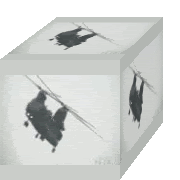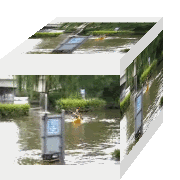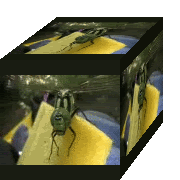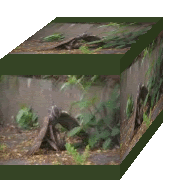 My investigations led me 3 miles away to this sign. Most English footpath signs point to such places as, 'Dingleberry Bottom' or 'Weston-under-Lizard', you know normal villages with normal names.
My investigations led me 3 miles away to this sign. Most English footpath signs point to such places as, 'Dingleberry Bottom' or 'Weston-under-Lizard', you know normal villages with normal names. This one is different. In fact it's probably the only one in the country....I hope!
This one is different. In fact it's probably the only one in the country....I hope! Another sign you don't see everyday.
Another sign you don't see everyday. This is the crater left by the biggest unnatural explosion anywhere on Earth until Hiroshima!
This is the crater left by the biggest unnatural explosion anywhere on Earth until Hiroshima! At 11.00 am, 27th November 1944, 4000 tons of high explosive blew up. A mushroom cloud 50 yards wide and upwards out of sight, threw out mounds of earth and rock up to a ton in weight and scattered debris for up to 11 miles away. The crater left was 400ft deep, 1/4 mile in diameter and covered an area of 12 acres. Afterwards the surrounding area was covered with a fine dust 4 inches deep, quietening footsteps and creating a moonscape. The blast was heard in London and recorded in Geneva as an earthquake.
At 11.00 am, 27th November 1944, 4000 tons of high explosive blew up. A mushroom cloud 50 yards wide and upwards out of sight, threw out mounds of earth and rock up to a ton in weight and scattered debris for up to 11 miles away. The crater left was 400ft deep, 1/4 mile in diameter and covered an area of 12 acres. Afterwards the surrounding area was covered with a fine dust 4 inches deep, quietening footsteps and creating a moonscape. The blast was heard in London and recorded in Geneva as an earthquake. Below these hills was a gypsum (a white rock used for making plaster) mine, which was being used as an arms dump. A vast amount of high explosive were stored as the build up to the Normandy invasion. As well as being a dump, bombs were repaired here. Returning bomber aircraft would drop any remaining bombs into soft marshland, they would be recovered and fixed at this site. It is thought that it was while work was being done on one of these, coupled that many of the bombs were stored ready armed ready for use that the tragedy happened. 70 lives were lost, 18 bodies were never recovered. Upper Castle Hayes farm, with all its buildings, wagons, cattle and people completely disappeared.
Below these hills was a gypsum (a white rock used for making plaster) mine, which was being used as an arms dump. A vast amount of high explosive were stored as the build up to the Normandy invasion. As well as being a dump, bombs were repaired here. Returning bomber aircraft would drop any remaining bombs into soft marshland, they would be recovered and fixed at this site. It is thought that it was while work was being done on one of these, coupled that many of the bombs were stored ready armed ready for use that the tragedy happened. 70 lives were lost, 18 bodies were never recovered. Upper Castle Hayes farm, with all its buildings, wagons, cattle and people completely disappeared.Thankfully, there wasn't a sympathetic explosion and the majority of the dump didn't explode, but even so buildings many miles away were damaged and the top of Fauld hill was removed from the skyline. The countryside was littered with live ordnance, Mills bombs, land mines, anti-personnel, detonators and 4000lb bombs. Rescues in the mine took 3 months due to pockets of gas, 10,000 tons of rubble and 6 million gallons of water from the nearby reservoir. One search party reported finding a cow standing in a field, twice its normal size, bloated with air from the shock wave. They tried to put it out of its misery by shooting it, but it failed to fall. On closer inspection it was found to be already dead, the angle of its legs holding it in the upright.
 For many years the truth of what had happened here was not disclosed. Kids used to play in the bomb hole, rolling rocks down its steep sides. It was not until recently that the area was fenced off and signs erected. In 1974 it was revealed that the explosion was caused by "bombs being taken out of store- primed for use and replaced unused, with detonators still installed." There is some speculation that it was actually caused by the impact of a German V-2 rocket. Parts of a fin similar to that on the V-2 were found. The V-2 rocket entered service in January 1944, it was the worlds first ballistic missile reaching a height of 55 miles before returning at supersonic speed and impacting at 1,780mph. The theory says that this is why there wasn't a 'sympathetic' explosion, as most of the stored bombs were displaced from the mine before they exploded. Many of the successful V-2 attacks were kept secret by the goverment in order to not demoralise the population or allow the Germans to calibrate their aim.
For many years the truth of what had happened here was not disclosed. Kids used to play in the bomb hole, rolling rocks down its steep sides. It was not until recently that the area was fenced off and signs erected. In 1974 it was revealed that the explosion was caused by "bombs being taken out of store- primed for use and replaced unused, with detonators still installed." There is some speculation that it was actually caused by the impact of a German V-2 rocket. Parts of a fin similar to that on the V-2 were found. The V-2 rocket entered service in January 1944, it was the worlds first ballistic missile reaching a height of 55 miles before returning at supersonic speed and impacting at 1,780mph. The theory says that this is why there wasn't a 'sympathetic' explosion, as most of the stored bombs were displaced from the mine before they exploded. Many of the successful V-2 attacks were kept secret by the goverment in order to not demoralise the population or allow the Germans to calibrate their aim.
 In the fields around the site are many of these war time buildings. They seem to be old shafts, now capped, many of them with signs of large calibre gun emplacements.
In the fields around the site are many of these war time buildings. They seem to be old shafts, now capped, many of them with signs of large calibre gun emplacements.
 For many years the truth of what had happened here was not disclosed. Kids used to play in the bomb hole, rolling rocks down its steep sides. It was not until recently that the area was fenced off and signs erected. In 1974 it was revealed that the explosion was caused by "bombs being taken out of store- primed for use and replaced unused, with detonators still installed." There is some speculation that it was actually caused by the impact of a German V-2 rocket. Parts of a fin similar to that on the V-2 were found. The V-2 rocket entered service in January 1944, it was the worlds first ballistic missile reaching a height of 55 miles before returning at supersonic speed and impacting at 1,780mph. The theory says that this is why there wasn't a 'sympathetic' explosion, as most of the stored bombs were displaced from the mine before they exploded. Many of the successful V-2 attacks were kept secret by the goverment in order to not demoralise the population or allow the Germans to calibrate their aim.
For many years the truth of what had happened here was not disclosed. Kids used to play in the bomb hole, rolling rocks down its steep sides. It was not until recently that the area was fenced off and signs erected. In 1974 it was revealed that the explosion was caused by "bombs being taken out of store- primed for use and replaced unused, with detonators still installed." There is some speculation that it was actually caused by the impact of a German V-2 rocket. Parts of a fin similar to that on the V-2 were found. The V-2 rocket entered service in January 1944, it was the worlds first ballistic missile reaching a height of 55 miles before returning at supersonic speed and impacting at 1,780mph. The theory says that this is why there wasn't a 'sympathetic' explosion, as most of the stored bombs were displaced from the mine before they exploded. Many of the successful V-2 attacks were kept secret by the goverment in order to not demoralise the population or allow the Germans to calibrate their aim. In the fields around the site are many of these war time buildings. They seem to be old shafts, now capped, many of them with signs of large calibre gun emplacements.
In the fields around the site are many of these war time buildings. They seem to be old shafts, now capped, many of them with signs of large calibre gun emplacements.






7 comments:
The poor cow!
What a great post. This is not something you see everyday. The history is fascinating as well. Thank you so much for sharing it with us!
xo
Blue
You make everything such an adventure.
I have a pile of huge boulders on my property.... hope there are no bombs underneath
I just found your blog. It is so interesting.
Yoli
Wow!!
My son would love your blog! I am going to give him your blog address when he comes home from Kuwait.
Please be careful on your adventures! I find myself holding my breath as I am reading your posts! LOL!
That poor poor cow.
I wonder how many secrets it DOES hold. So interesting!
Fascinating story and well researched.
Oscar Wilde said, "To look at a thing is very different from seeing it."
Most people merely look. You took the time to see. And we got the benefit of your effort!
Fascinating post.
(~_^)
So then the boulders at the beginning of your post must have been thrown there by the explosion. Fascinating post.
Post a Comment